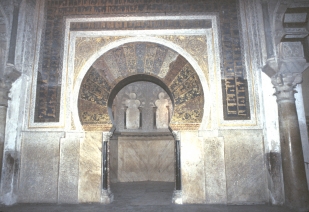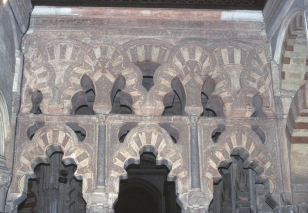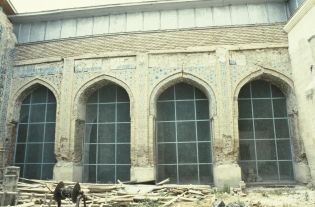This appendix includes various examples of variation in coördinate detail with reflection that are problematic or unresolved (for me), and which I have placed here to maintain the clarity of the body of this article.

Figure 1. Cordoba, Great Mosque, mihrab, lower portion.
The mosaic pseudovoussoirs of the horseshoe arch of the mihrab of the Great Mosque of Cordoba, which of course has been restored, possibly as early as 1771 and surely several times since, show what appears to be a perturbed pattern that I cannot resolve.1
The motifs are left- or right-twining foliate scrolls or fantastic foliate designs with symmetry of reflection. Ignoring the colors of the elements for a moment, the arrangement is
H G H G F E D C B A B C D E F G H G H
which has variation in coördinate detail with reflection out to the lower two voussoirs on either side, which repeat the motifs of the preceding two voussoirs in different colors. Exactly the four lowest voussoirs on either side are markedly Baroque in style (compare the others), so I assume they do not preserve the original arrangement. There is a clear, irregular joint between the central voussoirs and those on either side; the bottom five voussoirs on the left and the bottom six on the right fall on the lower side of this joint; according to Stern the lower sections are restorations,2 and so may be inventions, too. At the very least, then, and assuming that the central part of the arch reflects or preserves the original more reliably, the arrangement is
… D C B A B C D …
which is an example of variation in coördinate detail with reflection. The corresponding mosaic arches above the doors of the two neighboring bays, of which the eastern one has been affected by restoration, are arranged
H G F E D C B A B C D E F G H
with a strict alternation of gold and red backgrounds with predominantely blue foliate designs.
The distribution of color among the voussoirs of the mihrab is more complex, however, and exemplifies a kind of complication of the overall design that cannot be recovered for all monuments. The center voussoir (A) bears a gold foliate design on a blue background; the next two (B) are blue on gold; then gold on blue (C), blue on gold (D), and blue, outlined in gold, on red (E). The series is completed (in the zone I believe to be dubious) with blue on gold (F), gold on blue (G), blue on gold (H), gold on red (G), and gold on blue (H). This arrangement of color combinations works out to
GB GR BG GB BG BR BG GB BG GB BG GB BG BR BG GB BG GR GB
where the center voussoir is shown in bold type. Using the foreground color as the key and capitalizing the letters for the voussoirs with red backgrounds, this arrangement can be shown as
g G b g b B b g b g b g b B b g b G g
which is not a fully coherent pattern. Using the background color as the key, the arrangement is
b R g b g R g b g b g b g R g b g R b
The lowest voussoirs have blue backgrounds, and the eight voussoirs in between them, on either side, are two sets of gold-blue-gold separated by a red-background voussoir; the pattern is irregular in the use of a red background in the second lowest voussoirs. Cropping the arrangement to include only the central, more likely original voussoirs, I obtain
… R g b g b g b g R …
which is not really more coherent.

Figure 2. Cordoba, Great Mosque, interlaced arches in front of mihrab.
The famous interlaced lobed arches of the Great Mosque of Cordoba have been published and analyzed thoroughly by Ewert.3 They occur in the three bays in front of the mihrab (which must be contemporary with the mihrab, dated to 354/965 by inscription4) and in the so-called Capilla de Villaviciosa (thought to be of the same period5) The elements of their decoration that are of interest in the present context are the carved stucco pseudovoussoirs, which alternate with plain ones. Strictly speaking these are not entirely coördinate forms because of their varied shapes, but the importance of the monument demands attention to them. Analysis of this decoration is complicated by exactly this variable shape: it is often hard to tell whether the decoration of two differently shaped voussoirs was derived from the same model. In addition there must have been some restoration, and in some zones multiple hands are detectable.
There may be some way of analyzing the decoration abstractly I have not intuited (or perhaps more patience is required), but a straightforward survey of those arches that are not overlapped by others (that is, the arches all of whose voussoirs are visible) shows me no consistent pattern of decorative arrangement.
For the vertical faces of these arches the voussoirs generally display symmetry of reflection with respect to the center, vertical axis of the arch, although there are cases in which individual voussoirs fail to reflect those on the opposite side of the arch. I cannot find a consistent pattern of use of different designs; the following arrangement seems to be generally the intention for the arches of the three bays in front of the mihrab:6
C B C B A B C B C
The design principles at work in the arrangement of this decoration seem to be: give it symmetry of reflection with respect to the center, vertical axis; and ensure that no two adjacent voussoirs are the same (although there are examples of the latter, possibly a sign of restoration). This is a rather weak form of variation in coördinate detail.
I believe the same approach governs the carved decoration of the intrados sides of the voussoirs, but am less certain.

Figure 3. Malatya, Great Mosque, courtyard.
In the Great Mosque of Malatya (645/1247–48)7 one of the long sides of the courtyard retains some of the original tilework of its four bays. The spandrel patterns of each bays differs from the others. This arrangement might have been repeated across the courtyard, but no tile remains in the spandrels on that side.
1. [L.] T[orres-Balbás] “Restauración, en el siglo XVIII, de la cúpula que precede al miḥrāb de la Mezquita de Córdoba”, Al-Andalus, v. 4, 1936, pp. 198–200. For a brief overview of restorations of the mosaics of the mosque see Stern, op. cit., pp. 3–5, with details passim. E. Lévi-Provençal, Inscriptions arabes d'Espagne, 2 v., Paris, 1931, v. 1, p. 15, attributed the disruption of the lower part of the vertical sections of the inscription framing the arch to a restoration of 1816. That date is evidently a misprint, as Manuel Ocaña Jimenez, “Inscripciones arabes fundacionales de la Mezquite-Catedral de Cordoba”, Cuadernos de Madīnat al-Zahrā', v. 2, 1990, pp. 9–28, p. 9, states that the Bāb Bayt al-Māl or Puerta de la Cámara del Tesoro was subjected in 1916 to a restoration “bastante libre y gratuita, dirigida por el arquitecto don Ricardo Velázquez Bosco”, who was working at that time rather than a century before. He says that it duplicated the mosaic of the Bāb al-Sābāṭ or Puerta del Pasadizo, which is the door west (to the right) of the mihrab (Stern, op. cit., p. 1).
2. Op. cit., p. 16.
3. Spanisch-Islamiche Systeme sich kreuzender Bögen (Madrider Forschungen, v. 2), Berlin, 1968.
4. Op. cit., p. 5.
5. Op. cit., p. 7.
6. Particularly clear in Ewert's pl. 10, but cf. the center three voussoirs in pl. 6 and 7, for example.
7. É. Combe, et al., Répertoire chronologique d'épigraphie arabe, v. 11, no. 4275, pp. 180–81.